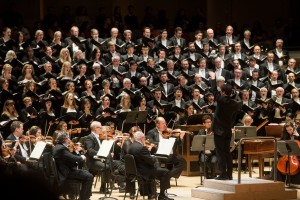This article appears in The WholeNote as part of our collaboration in the Emerging Arts Critics programme.
 Traditions are at the heart of the holiday season and George Frideric Handel’s Messiah is undoubtedly a holiday essential.
Traditions are at the heart of the holiday season and George Frideric Handel’s Messiah is undoubtedly a holiday essential.
Taking the form of an oratorio, Handel’s Messiah features orchestra, choir and four soloists, and in three parts, tells the story of God’s redemption of humankind. Part One focuses on the birth of Jesus, Part Two navigates His death, and Part Three offers a view into Christ as Saviour. Messiah was originally conceived of as a work for Easter but by the Victorian period, it had found a home amongst Christmas celebrations and has remained so ever since.
On the evening of December 18 at Roy Thomson Hall, the Toronto Symphony Orchestra (TSO) was ready to delight audiences again with its annual production of Handel’s Messiah.
This year, the TSO presented itself as a smaller string orchestra, absent of many of the brass and woodwinds but including a harpsichord – a gesture to the Baroque era to which Messiah belongs. The Toronto Mendelssohn Choir (TMC), which typically performs under the artistic direction of Noel Edison, sat directly behind the orchestra onstage. When the lights dimmed, guest conductor Matthew Halls entered the stage, followed by the four finely dressed soloists: baritone Joshua Hopkins, tenor Frédéric Antoun, mezzo-soprano Krisztina Szabó and soprano Karina Gauvin.
After a resounding opening overture to Part One by the orchestra, Frédéric Antoun began to beautifully sing the tenor accompagnato “Comfort ye.” He skilfully handled the music’s melismatic passages and gave a thoroughly engaging performance. When the choir rose from their seats and entered with the chorus “And the glory of the Lord,” their full sound marked a distinct departure from the soloist. Seeing the entire choir standing behind the orchestra was stunning – and hearing their rich tone added to this awe.
A shower of applause came down after this segment, and an unusually long silence followed until baritone Joshua Hopkins walked to the centre of the stage and began his accompagnato “Thus saith the Lord.” His deep voice carried effortlessly through the hall – and also carried away any remaining confusion over the empty silence that had preceded.
With the opening notes of the mezzo-soprano air “But who may abide the day of His coming,” Krisztina Szabó quickly established herself as a strong and exquisite performer. She embraced the dramatic element of the performance as much as the vocal technique and musicality, and was captivating to watch and listen to throughout the concert.
The recitative “There were shepherds abiding in the field” introduced soprano Karina Gauvin, who treated each of her notes with poise and made them shimmer despite the high register. Like Szabó, she heeded the drama associated with performance, particularly in Part One’s “Rejoice greatly.” Giving warm smiles throughout her performance, she demonstrated that audience and performers alike could share in the enjoyment of the piece.
When the orchestra offered up the first notes of the Hallelujah chorus at the end of Part Two, a current of excitement rippled through the audience. Adhering to tradition, people began to rise for the chorus.
The practice of standing during the Hallelujah chorus was started in London, when King George II supposedly stood up during that part of the piece. Royal protocol ordained that everyone had to stand when a monarch did, so the rest of the audience followed suit. The enduring custom is equally a learning experience for those uninitiated to a live Messiah performance and a powerful marking of tradition for seasoned attendees.
In Part Three, the instrumentalists of the TSO brought the notion of celebration immediately to mind. The bright and joyous trumpet solo added liveliness and vivacity to Hopkins’ “The trumpet shall sound” – and the buildup of energy and excitement channelled by the timpani kept the audience on the edges of their seats until the final chord rung out into the hall.
Halls’ conducting moved Messiah along with great energy and vibrancy. He conducted the entire work from memory, the music guiding him as much as he guided the performers. And while there were a few moments where the ritardandos between the orchestra and soloists didn’t quite line up, these minor slips simply spoke to the work being a collective human effort, inclusive of imperfections and triumphs alike.
When Halls’ arms came down after the final chord, his hands swiftly came together to applaud the musicians and singers. The audience also didn’t waste any time getting to their feet and offered all the performers ample applause.
Handel’s Messiah is truly a work that demands to be experienced – and under the direction of Halls, the TSO did a spectacular job of bringing the piece to life and fulfilling holiday traditions in which Messiah has found a cherished place.
The Toronto Symphony Orchestra presented Handel’s Messiah from December 18 to 23, 2017 at Roy Thomson Hall, Toronto.
Melissa Poon has always considered the arts, music and performance to be essential aspects of her life. She is a classically trained violinist and flutist, an avid regular at the orchestra and theatre, and a wishful world traveller.

